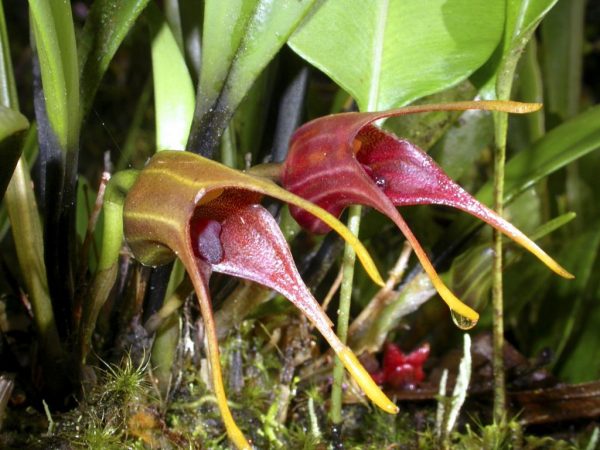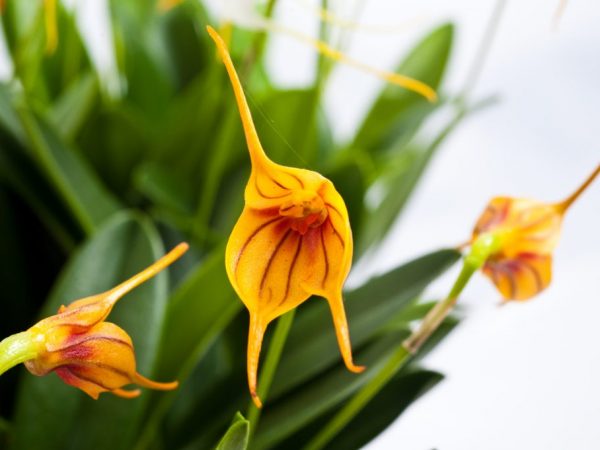How to care for the Masdevallia orchid
Masdevallia Orchid is a collective name for a large group of plants. They are distinguished by their miniature size and beautiful flowers of an unusual shape. Due to their small size, they are the best suited for growing at home.

Masdevallia Orchid
general information
These plants were brought to us from South America. In nature, they are distributed from Mexico and further south, to Peru. They are most fully represented in the forests of Colombia and Ecuador. The genus Masdevallia unites about 500 species of small orchids. Among them there are epiphytes (parasitizing on trees), lithophytes (attached to rock surfaces) and even terrestrial varieties.
Popular types
In our country, such flowers have appeared relatively recently and are little known to flower growers. The most widespread in Russia are the following types of Masdevallia:
- Commodity;
- Fiery red;
- Glandular;
- Triangular;
- Nondefica;
- Davis;
- Ezhova.
Care rules
To grow a healthy plant, you need to follow the rules of caring for it.
Lighting
The orchids are provided with bright lighting. The light should be diffused. Direct sunlight is not allowed. It is better to place the pot on windows facing east or west. On the south side, the flower is covered from the sun. If the window faces north, additional lighting will be needed.
Daylight hours should last 10-12 hours.
Temperature regime
Masdevallia doesn't like warmth. It is better to keep it in moderately cool rooms.
These orchids need a daily temperature drop. Optimal conditions for summer time: during the day - from 15 ° С to 25 ° С, at night - from 10 ° С to 15 ° С.
After the end of the night spring frosts, the flower pot is placed on the balcony. The main thing is to make sure that direct sunlight does not fall on the leaves.
Air humidity

Air humidity is important for a plant
Caring for an orchid involves maintaining the humidity level in the room. If the room is kept cool, the humidity should be about 50%. On hot summer days, humidity is increased to 80-90%. This is done using household humidifiers. Spraying with warm water several times a day also helps.
Watering
Orchids are demanding on moisture. They need to be watered often and abundantly. They constantly make sure that the roots on one side are not waterlogged, and on the other, do not dry out. Waterlogging leads to the formation of rot and death of the flower. Drying out is also contraindicated, since the roots, due to the structural features, are not able to hold water for a long time.
For irrigation, use soft warm water with a temperature of about 40 ° C. The pot with the plant is placed in a bowl of water and left for 15-25 minutes. This allows you to properly saturate the roots and substrate with water. Then the pot is returned to its place.
A shower is also useful, which is carried out with hot water at a temperature of up to 45 ° C. Watering is carried out without waiting for the complete drying of the substrate.
Substrate
Pine bark is suitable as a substrate for Masdevallia.If the flower grows in a pot, use small pieces. At the bottom of the pot, make a small pillow of sphagnum moss. Then add the crushed bark, which fills the space between the roots. A layer of moss is also laid out on top. Sphagnum is needed so that moisture does not evaporate too quickly. For additional ventilation of the root system, holes are made in the walls of the pot.
Another option is to use blocks. These are large pieces of pine bark to which the roots are attached. Sphagnum pillows are also made at the top and bottom of the block.
Fertilizer
Any fertilizer for orchids is suitable for feeding, for example, Agricola.
Flowers are fertilized every 3-4 weeks during the active growth phase. For this type of plants, 1/3 or 1/2 of the recommended fertilizer dose is limited. Apply both root dressing and spraying.
All of the above is also true for plants belonging to the Dracula genus (80 species). These are miniature flowers of original color and shape. Caring for them is carried out in the same way.
Summarizing
Growing Masdevallia and related species at home is a feasible task. But it is necessary to tackle its solution with experience: it is not easy to create the necessary conditions.


